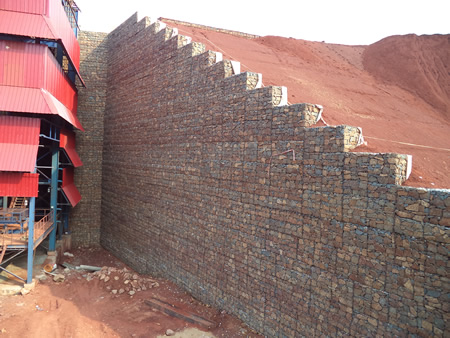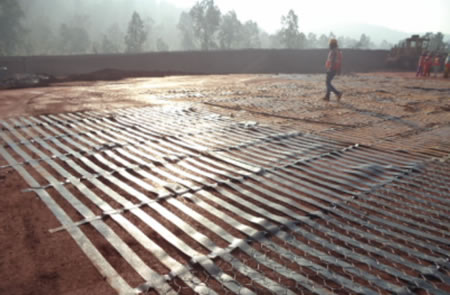



By Maccaferri – Serajuddin Mines wanted to build a central ore handling plant at its facility in Joda, Orissa, in India. Joda is a city in the Kendujhar district of the state. It is an area that has rich iron ore deposits and the economy centres on the large-scale production of steel.
SERAJUDDIN MINES
To facilitate the construction of the plant infrastructure, access works were required to accommodate a 22m-high loading bin at the site of the primary crusher.
The terrain at the design location was extremely challenging and a retaining wall was necessary to create a safe platform for heavy duty unloading trucks. Here, as at many other mining sites, the reinforced soil structures within tip and crusher walls needed to withstand loaded vehicles in excess of 300 tonnes.
Maccaferri, with 130 years of civil, geotechnical, and hydraulic engineering experience, was approached to provide a solution that would enable the client to meet production requirements while keeping capital and operational costs to a minimum.
A VERTICAL, REINFORCED SYSTEM
Maccaferri’s Terramesh® System was selected for its inherent flexibility, including in tall walls. The system, made from heavily galvanised steel wire mesh with an additional polymer coating, is engineerined for long-term design strength and technical performance without being compromised by chemical, biological, or environmental degradation.
Used in combination with reinforcement geosynthetics, it can create tall, vertical walls for difficult applications like mine crusher walls.
For Serajuddin, a 22m-high vertical wall was designed using the MacStars W design software.
The engineered solution utilized:
- Terramesh® System modular soil reinforcement system
- ParaLink® high performance geogrid
- Nonwoven geotextile
High-strength ParaLink® reinforcement was provided at 1m centers throughout the structure. This complemented the Terramesh® units, which provided the wall fascia element with an integral geogrid used as secondary soil reinforcement. Reinforcement length at the main wall section was about 16m.
The nonwoven geotextile, a Terram 1000, was inserted behind the gabion facia units (Terramesh®) as a separator.
Once completed, the 22m-high crusher wall had a surface area of 1771m2. A wing wall on each side of the main wall tapered off at a slope of 1:2 (V:H) with an overall length of 82m.
The wall was founded on a 1m-thick foundation of compacted granular material. Only pre-approved selected soil was used as backfill and compacted to 95% (+/- 2%) Proctor density. Quality control of compaction on site was strictly monitored.
CONSTRUCTION & MATERIALS
To offer the clients a best value and a more environmentally friendly solution, Maccaferri made available a wide range of products. This selection process included the reuse of site-won materials. With the geosynthetics able to work with so many on-site soils, the carbon footprint of the construction works was driven down considerably.
Harvesting, processing, and transporting special fill is a carbon-intensive activity. Construction activities are a major contributor to the world’s carbon footprint, but smart engineering and utilization of geosynthetic-related solutions can have a strong and beneficial impact on construction-related CO2.
Also, the reuse of site soils, such as for structural backfill, reduced the site construction time frame—which saved on project cost too.
Additional time savings and project economy were realized through the supply of geogrid rolls with the correct “tail length” measurements. The installation contractor, Thriveni Earthmovers Pvt. Ltd, was able to quickly, efficiently, and safely deploy the rolls in the properly designed spaces with minimal waste.
A full-time on-site supervisor strictly monitored quality control of the materials and construction, ensuring the integrity of the crusher wall.
Finally, the personal and economic impact on the area should not be overlooked. Mining activity provides various economic spurs for the area, but the crusher wall construction itself provide a much-needed local boost to the economy through the employment of 70 labourers a day.
The project was completed successfully in two months.
For more information and project stories, visit www.maccaferri.com.











